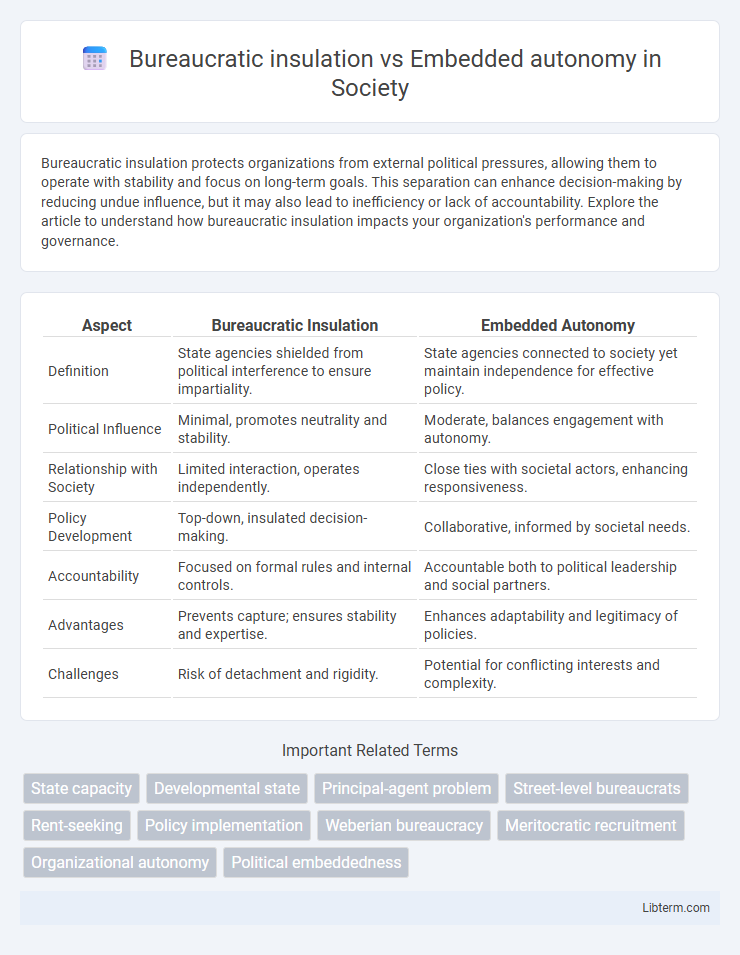Bureaucratic insulation protects organizations from external political pressures, allowing them to operate with stability and focus on long-term goals. This separation can enhance decision-making by reducing undue influence, but it may also lead to inefficiency or lack of accountability. Explore the article to understand how bureaucratic insulation impacts your organization's performance and governance.
Table of Comparison
| Aspect | Bureaucratic Insulation | Embedded Autonomy |
|---|---|---|
| Definition | State agencies shielded from political interference to ensure impartiality. | State agencies connected to society yet maintain independence for effective policy. |
| Political Influence | Minimal, promotes neutrality and stability. | Moderate, balances engagement with autonomy. |
| Relationship with Society | Limited interaction, operates independently. | Close ties with societal actors, enhancing responsiveness. |
| Policy Development | Top-down, insulated decision-making. | Collaborative, informed by societal needs. |
| Accountability | Focused on formal rules and internal controls. | Accountable both to political leadership and social partners. |
| Advantages | Prevents capture; ensures stability and expertise. | Enhances adaptability and legitimacy of policies. |
| Challenges | Risk of detachment and rigidity. | Potential for conflicting interests and complexity. |
Understanding Bureaucratic Insulation: Definition and Core Features
Bureaucratic insulation refers to the deliberate separation of a bureaucracy from external political pressures to enhance its impartiality and effectiveness, characterized by legal protections, stable tenure for officials, and autonomous decision-making capabilities. Core features include immunity from partisan influence, institutional mechanisms that buffer policy implementation from political volatility, and a clear hierarchy that supports expert-driven administration. This insulation fosters consistency in public policy and reduces susceptibility to short-term political interests, distinguishing it from embedded autonomy where bureaucracies maintain close ties with political leaders while preserving some operational independence.
What Is Embedded Autonomy? Key Concepts and Principles
Embedded autonomy refers to a governance framework where state bureaucracies maintain sufficient autonomy to formulate policies independently while being deeply connected to social and economic actors. This concept emphasizes a balance between insulation from political pressures and constructive engagement with interest groups to foster effective state-led development. Key principles include reciprocal trust, dense networks of communication, and institutional capacity that enable coordinated action without undue external interference.
Historical Origins: Tracing the Evolution of Both Models
Bureaucratic insulation emerged in the early 20th century, emphasizing the separation of administrative agencies from political pressures to enhance efficiency and impartiality. Embedded autonomy developed later, rooted in mid-20th century theories like Evans' state-society collaboration model, highlighting the state's capacity to engage with society while retaining control. Both models evolved from attempts to balance state capacity and responsiveness, reflecting shifts in governance strategies across industrial and developing nations.
Bureaucratic Insulation vs Embedded Autonomy: Key Differences
Bureaucratic insulation emphasizes shielding government agencies from political pressures to ensure neutral policy implementation, while embedded autonomy involves close collaboration between the state and private sector to promote coordinated economic development. Key differences lie in insulation promoting bureaucratic independence to avoid external influences, whereas embedded autonomy fosters strategic ties that leverage mutual trust and expertise. Bureaucratic insulation often results in rigid administration, contrasting with the flexibility and innovation encouraged by embedded autonomy.
Impacts on Policy Implementation and Governance
Bureaucratic insulation ensures policy implementation remains stable by shielding agencies from political pressures, enhancing expertise and continuity. Embedded autonomy balances state capacity with societal engagement, driving responsive governance through close networks between bureaucrats and interest groups. Both frameworks impact governance effectiveness by shaping how policies are executed and adapted to dynamic political contexts.
Case Studies: Bureaucratic Insulation in Practice
Case studies of bureaucratic insulation reveal how governments shield agencies from political pressures to enhance policy implementation and administrative efficiency. South Korea's Economic Planning Board exemplifies bureaucratic insulation by functioning independently to drive rapid industrialization during the 1960s and 1970s without direct political interference. Contrastingly, embedded autonomy, as seen in Germany's social market economy, balances bureaucratic expertise with close ties to political institutions, highlighting different approaches to state capacity and governance.
Case Studies: Embedded Autonomy in Action
Case studies of embedded autonomy showcase governments effectively balancing bureaucratic insulation with political engagement to foster innovation and economic growth. South Korea's Ministry of Trade, Industry, and Energy exemplifies embedded autonomy by maintaining technical expertise while collaborating closely with the private sector to drive industrial policy. This model contrasts with bureaucratic insulation, where excessive separation from political influences can hinder adaptive and responsive governance.
Economic Development Outcomes: A Comparative Analysis
Bureaucratic insulation often leads to economic development by protecting agencies from political interference, ensuring consistent policy implementation and regulatory stability. Embedded autonomy combines strong, insulated bureaucracies with close ties to political leaders and stakeholders, facilitating coordinated economic strategies and adaptive governance. Comparative analyses reveal that countries balancing bureaucratic insulation with embedded autonomy, such as South Korea and Taiwan, achieve superior economic development outcomes through efficient state-led industrial policies and innovation-led growth.
Challenges and Criticisms of Each Approach
Bureaucratic insulation faces challenges such as reduced accountability and potential disconnect from political realities, leading to inefficiencies and resistance to change. Embedded autonomy risks bureaucratic capture and politicization, where close ties between the state and interest groups may compromise impartial policy implementation. Both approaches are criticized for balancing the tension between independence and responsiveness, with debates focusing on which model better promotes effective and adaptive governance.
Future Directions: Balancing Insulation and Autonomy for Effective Governance
Future directions in governance emphasize the need to balance bureaucratic insulation with embedded autonomy to enhance policy effectiveness and responsiveness. Integrating insulated agencies that safeguard against political interference with embedded teams that maintain close ties to political leaders promotes adaptive and accountable institutions. Developing hybrid governance models that leverage both insulation for stability and embeddedness for flexibility supports sustainable development goals and innovation in public administration.
Bureaucratic insulation Infographic

 libterm.com
libterm.com